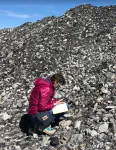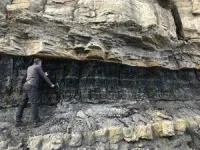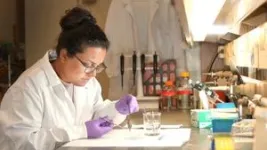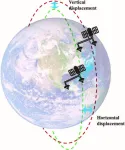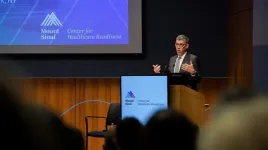(Press-News.org) Deposits of designated critical minerals needed to transition the world’s energy systems away from fossil fuels may, ironically enough, be co-located with coal deposits that have been mined to produce the fossil fuel most implicated in climate change.
Now, research led by the University of Utah has documented elevated concentrations of a key subset of critical minerals, known as rare earth elements, or REEs, in active mines rimming the Uinta coal belt of Colorado and Utah.
These findings open the possibility that these mines could see a secondary resource stream in the form of metals used in renewable energy and numerous other high-tech applications, according to study co-author Lauren Birgenheier, an associate professor of geology and geophysics.
“The model is if you're already moving rock, could you move a little more rock for resources towards energy transition?” Birgenheier said. “In those areas, we're finding that the rare earth elements are concentrated in fine-grain shale units, the muddy shales that are above and below the coal seams.”
This research was conducted in partnership with the Utah Geological Survey and Colorado Geological Survey as part of the Department of Energy-funded Carbon Ore, Rare Earth and Critical Minerals project, or CORE-CM. The new findings will form the basis for a grant request of an additional $9.4 million in federal funding to continue the research.
While these metals are crucial for U.S. manufacturing, especially in high-end technologies, they are largely sourced from overseas.
"When we talk about them as 'critical minerals,' a lot of the criticality is related to the supply chain and the processing," said Michael Free, a professor metallurgical engineering and the principal investigator on the DOE grant. "This project is designed around looking at some alternative unconventional domestic sources for these materials."
The association between coal and REE deposits has been well documented elsewhere, but little data had been previously gathered or analyzed in Utah and Colorado’s coal fields.
“The goal of this phase-one project was to collect additional data to try and understand whether this was something worth pursuing in the West,” said study co-author Michael Vanden Berg, Energy and Minerals Program Manager at the Utah Geological Survey. “Is there rare earth element enrichment in these rocks that could provide some kind of byproduct or value added to the coal mining industry?”
Researchers analyzed 3,500 samples from 10 mines, four mine waste piles, seven stratigraphically complete cores, and even some coal ash piles near power plants.
“The coal itself is not enriched in rare earth elements,” Vanden Berg said. “There's not going to be a byproduct from mining the coal, but for a company mining the coal seam, could they take a couple feet of the floor at the same time? Could they take a couple feet of the ceiling? Could there be potential there? That's the direction that the data led us.”
The team deployed two different methods to record levels of rare earths, expressed in parts per million, or ppm, in the samples. One was a hand-held device for quick readings in the field, the other used Inductively Coupled Plasma-Mass Spectrometry, or ICP-MS, in an on-campus lab.
“We’re mostly using this portable x-ray fluorescence device, which is an analysis gun that we hold to the rock for two minutes, and it only gives us five or six of the 17 rare earth elements,” Birgenheier said. If samples showed concentrations higher than 200 ppm, they ran a more complete analysis using the more costly mass spectrometry equipment.
The Department of Energy has set 300 ppm as the minimum concentration for rare earth mining to be potentially economically viable. But for the study, researchers deemed concentrations greater than 200 ppm to be considered “REE enriched.”
The study found the highest prevalence of such concentrations in coal-adjacent formations of siltstone and shale, while sandstone and the coal itself were mostly devoid of rare earths.
The team has analyzed 11,000 samples to date, far more than were used in the published study. Next steps include determining how much rare earth ore is present, likely to be done with colleagues at the University of Wyoming and New Mexico Institute of Mining and Technology.
####
Titled "Rare earth element enrichment in coal and coal-adjacent strata of the Uinta Region, Utah and Colorado," the study appeared April 26 in Frontiers of Earth Science.
END
EMBARGOED FOR RELEASE: MONDAY, MAY 20, 2024, 3:00 PM ET
Key points:
Replacing an average diesel school bus from 2017 with an electric one may result in $84,200 in health and climate benefits—including fewer greenhouse gas emissions and reduced rates of mortality and childhood asthma—per individual bus.
Those benefits may increase to $247,600 per individual electric school bus replacing a diesel bus from 2005 or earlier in a large metropolitan area.
While the benefits of replacing diesel vehicles with electric ones are well known, this is the first study to specifically quantify the health and climate benefits of replacing diesel school buses with electric ...
Endoscopes are instruments that are used to look inside the body
Even with new developments cleaning them sufficiently has been a challenge
The University has entered a knowledge transfer partnership (KTP) with PFE Medical to improve the process by removing bacterial biofilm inside them.
Aston University experts are teaming up with a medical products company to improve the cleaning of endoscopes.
Endoscopes are long, thin instruments with a light and camera at one end that are used to look inside the body.
Cleaning them sufficiently has been a challenge and even with new developments they can ...
LA JOLLA, CA — The brain is often referred to as a “black box”—one that’s difficult to peer inside and determine what’s happening at any given moment. This is part of the reason why it’s difficult to understand the complex interplay of molecules, cells and genes that underly neurological disorders. But a new CRISPR screen method developed at Scripps Research has the potential to uncover new therapeutic targets and treatments for these conditions.
The method, outlined in a study published in Cell on May 20, 2024, provides a way to rapidly examine the brain cell types ...
Image
Artificial neural networks may soon be able to process time-dependent information, such as audio and video data, more efficiently. The first memristor with a 'relaxation time' that can be tuned is reported today in Nature Electronics, in a study led by the University of Michigan.
Memristors, electrical components that store information in their electrical resistance, could reduce AI's energy needs by about a factor of 90 compared to today's graphical processing units. Already, AI is projected to account for about half a percent of the world's total electricity ...
EMBARGOED UNTIL: 10:15 a.m. PT, Monday, May 20, 2024
PARC MODEL OF CARE ASSOCIATED WITH FEWER DEATHS AMONG VETERANS POST-ICU
Session: B18 – Bridging Gaps to Improve Long-Term Outcomes
The Post-Acute Recovery Center: A Telehealth Care Model to Improve Patient-Centered Outcomes for High-Risk Survivors of Critical Illness
Date and Time: Monday, May 20, 2024, 10:15 a.m. PT
Location: San Diego Convention Center, Room 32A-B (Upper Level)
ATS 2024, San Diego – Research presented at the ATS 2024 International Conference demonstrates that veterans who received ...
WASHINGTON, D.C. - Today, the U.S. Department of Energy (DOE) announced $6 million in funding for 12 awards across eight efforts to advance research in isotope enrichment, targetry, and separations. This funding is part of a key federal program that produces critical isotopes otherwise unavailable or in short supply in the U.S.
Isotopes, or variations of the same elements that have the same number of protons but different numbers of neutrons, have unique properties that make them powerful in medical diagnostic and treatment applications. They are also essential for applications in quantum information science, nuclear power, national security, and more.
“These ...
UNDER EMBARGO UNTIL 19:00 BST / 14:00 ET MONDAY 20 MAY 2024.
World leaders still need to wake up to AI risks, say leading experts ahead of AI Safety Summit
More information, including a copy of the paper, can be found online at the Science press package at https://www.eurekalert.org/press/scipak/, or can be requested from scipak@aaas.org
Leading AI scientists are calling for stronger action on AI risks from world leaders, warning that progress has been insufficient since the first AI Safety Summit in Bletchley Park six months ago.
Then, the world’s leaders pledged to govern AI responsibly. However, as the second AI Safety Summit in Seoul ...
Although researchers have warned of the extreme risks posed by rapidly developing artificial intelligence (AI) technologies, there is a lack of consensus about how to manage them. In a Policy Forum, Yoshua Bengio and colleagues examine the risks of advancing AI technologies – from the social and economic impacts, malicious uses, and the possible loss of human control over autonomous AI systems – and recommend directions for proactive and adaptive governance to mitigate them. They call on major technology companies and public funders to invest more – at least one-third of their budgets – into assessing and ...
The new Tandem Dual-Antenna Spaceborne Synthetic Aperture Radar (SAR) Interferometry (TDA-InSAR) system, addresses the limitations of current spaceborne Synthetic Aperture Radar (SAR) systems by providing a more reliable and efficient method for 3D surface mapping. The system's innovative design allows for single-pass acquisitions, significantly reducing the time required for data collection and enhancing the precision of 3D reconstructions in various terrains, including built-up areas and vegetation canopies.
Synthetic Aperture Radar (SAR) interferometry (InSAR) is a powerful tool for producing high-resolution topographic maps. However, traditional InSAR techniques face ...
The Icahn School of Medicine at Mount Sinai announced the launch of its new Center for Healthcare Readiness, bringing together a diverse team of academic and operational experts to strengthen the Mount Sinai Health System’s strategies and the U.S. health care sector’s capacity to prepare for and respond to any large-scale public health emergency.
The Center will work with both Mount Sinai’s own resources, and public and private partners at the local, regional, and federal levels, to pursue strategies in research, advocacy, innovation, and collaboration to plan ...
